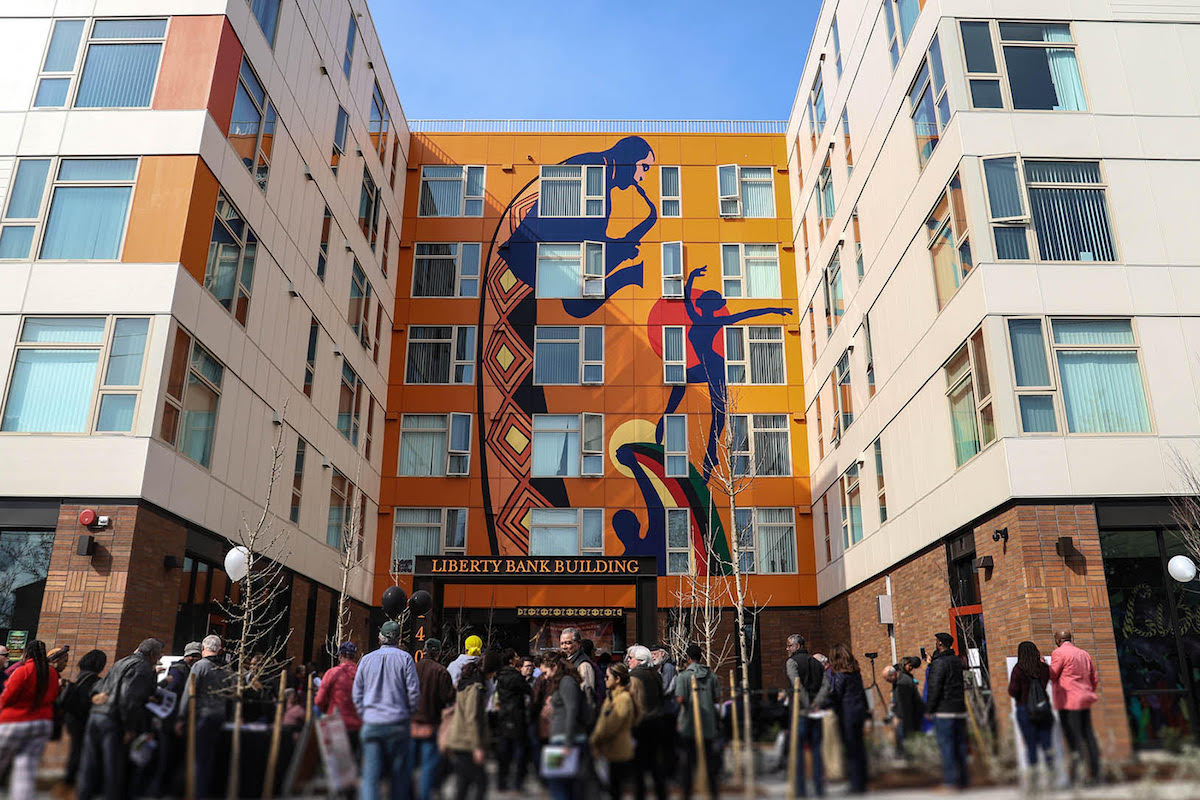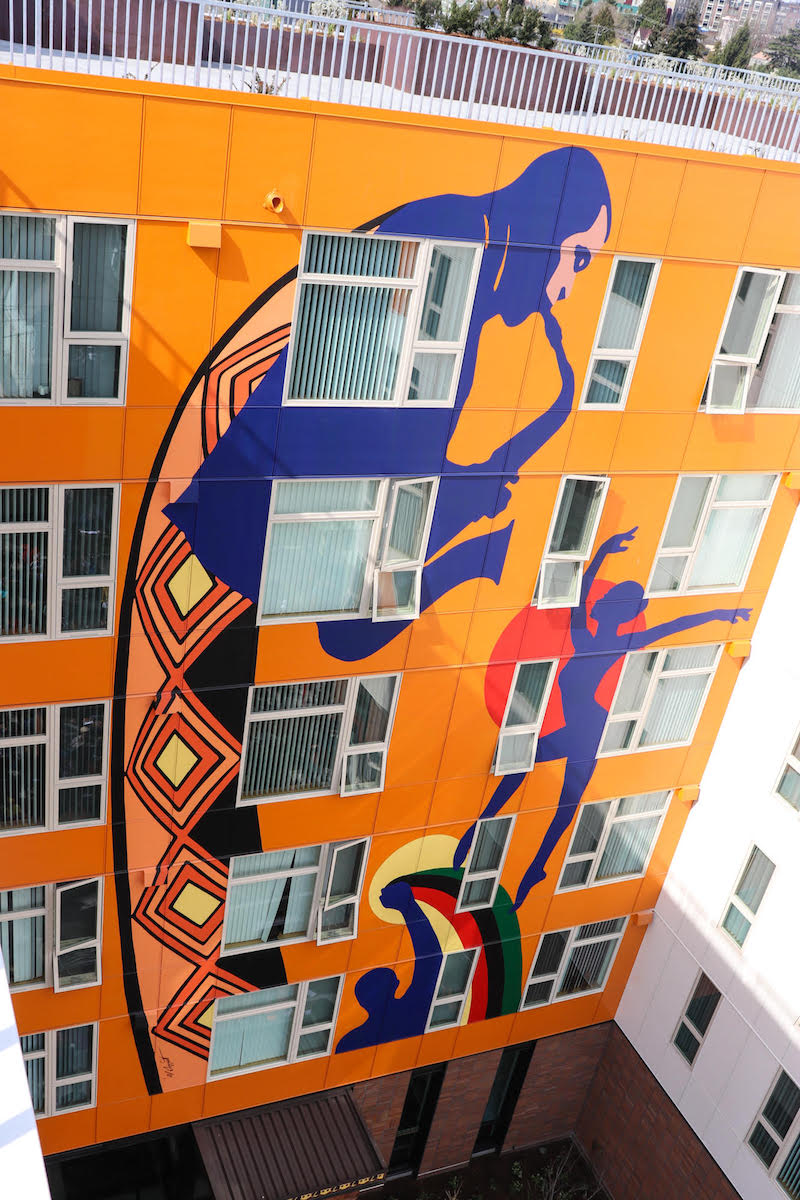
On the corner between 24th and Union in the Central District, a five-story mural covering a six-story apartment complex depicts a man playing the saxophone. The artwork shows woman dancing beneath the saxophone player, alongside green, red, and black accents on top of a vibrant orange background.
The mural pays homage to the pan-African community of Central District and to the legacy of the building itself.
In 1968 the building was Liberty Bank, the first black-owned bank west of the Mississippi River. In response to redlining in the Central District, the founders of the bank sought to provide financial support to marginalized communities who were turned away by white-owned banks.
And today, a group of community partners have redeveloped the Liberty Bank property in a way that centers the housing and business needs of the neighborhood’s black community and preserves this space despite the rapid gentrification of the Central District.
For 20 years Liberty Bank served the Central District community until it closed in 1988.
Eventually the Liberty Bank building was bought by Key Bank, which sold the property in 2015 to Capitol Hill Housing. The housing agency and other key Central District leaders wanted to honor the Liberty Bank founders’ by developing the building into a $34 million affordable housing complex, with community space and retail space. Other partners listed by Capitol Hill Housing include Africatown-Central District Preservation and Development Association, the Black Community Impact Alliance and Byrd Barr Place.
The purchase came as the Central District’s population changed drastically, with many African American families and other families of color forced out due to increases in the costs of housing and living brought on by Seattle’s growing population as a technology city.
In the 1960s and ‘70s, Central District was 70% black. Today, African Americans are now in the minority of this historically black neighborhood. Only 20% of the Central District’s population is African American — a decrease of 50 percentage points.
In March, Capitol Hill Housing opened the new development, calling it Liberty Bank Building in honor of the building’s historic significance.
It features 2,695 square feet for local black businesses and 115 affordable homes for the community. The one, two and studio bedroom affordable housing apartments range from $448 to $1,013, and are available to people making 30% to 60% of the area median income.
So far, the housing agency’s efforts have helped maintain the traditional community of this rapidly changing neighborhood. About 87% of the housing at the Liberty Bank Building is occupied by black residents.
Three black-owned businesses have signed leases to open in the new space — Cafe Avole, That Brown Girl Cooks and Earl’s Cuts and Styles barbershop. The barbershop, a stronghold in the Central District for decades, is holding a crowdfunding campaign to cover its moving permits, advertising its new location and the purchase of new barbershop equipment.
Honoring the neighborhood
Affordable housing was not the only goal for the project. The community and developers also created a building that used art to reflect the bank and community.
Nine black artists with ties to the community collaborated on the artwork, which was an investment of more than $250,000.
The massive mural on the exterior was created by artist Al Doggett. Doggett was also the co-curator of the entire art development.
“My vision was to highlight the history of Central District and the history of Liberty Bank,” Doggett said. “Although our artists have the freedom to choose a variety of themes, the community actually dictated the direction of the artwork. For years we sat in meetings going back and forth over designs, concepts, and preliminaries.”
One of the biggest challenges was tying in a collaboration of African American and pan-African contemporary art on a building. Artists focused on the image to overcome their struggles.

Now, the exterior of the building features Doggett’s mural, plaques where you can learn about the bank’s founders, interactive displays to learn the communities’ history and a statue of swimming salmon in an ode to the Pacific Northwest.
The banks’ original logo is front and center beside the building’s new sign. Inside, the building, the original bank vault door has been transformed into a large art piece.
Along the walls, the artwork features bank lockboxes in the entrance archway, the founders’ faces, and information about the building’s history. The inside of the building includes an arts and crafts room for residents.
With the help of Doggett and his team, the building’s interior and exterior now reflect its past and Central District’s hope to reclaim their community.
“Making pieces, and knowing that it benefits not only me as an artist but empowered the community as well was very pleasing. There were very few disagreements as we came together to make this happen as a community,” Doggett said.



Warm and toasty article BUT if you look into the history of Liberty Bank maybe its story isn’t . It was open for just 20yrs. and was not well run. There main (stated) goal was to provide real estate loans hindered greatly by hiring practices.
Hi Phil, thanks for your comment. In 1988 it was closed due to “deficits and uneven profits” (https://www.blackpast.org/african-american-history/liberty-bank-seattle-washington-1968-1988-and-liberty-bank-building/). Additionally, yes the bank’s goal was to provide financial assistance to people of color and those who lived in the community who were turned away from white owned banks.
Hi Phil, thanks for your comment. In 1988 it was closed due to “deficits and uneven profits” (https://www.blackpast.org/african-american-history/liberty-bank-seattle-washington-1968-1988-and-liberty-bank-building/). Additionally, yes the bank’s goal was to provide financial assistance to people of color and those who lived in the community who were turned away from white owned banks.
Didn’t Liberty Bank go broke ? and had to be taken over by another bigger
bank in town becauise of mis management ? I remember the bank. Had
an account their.
Hi Steve, Liberty Bank did reopen as Emerald City Bank. Afterward it was bought by Key Bank. In 2015 Key Bank offered to sell it with the intention of making it into affordable housing.
Hi Steve, Liberty Bank did reopen as Emerald City Bank. Afterward it was bought by Key Bank. In 2015 Key Bank offered to sell it with the intention of making it into affordable housing.
Unfortunately the new Liberty Bank Building affordable housing has become a terrible nuisance to this once wonderful peaceful neighborhood in just a few short months since opening. They have decided to sponsor open air rooftop parties every Thursday night (Level R Productions) blaring music across this once quite peaceful neighborhood. Think the type of people who blast music on trails or in thier cars up and down the strip and you begin to understand the negative impact this building is fixing on the community. We live over six blocks away and can hear the music in our home with the window and doors closed. Sad that this is what the development is known for.
It is a shame that in the short time that this building has been part of our neighborhood they have chosen to distinguish themselves as one of most disruptive neighbors. Hosting excessively loud rooftop parties that force music into the homes of this quiet community is not what we had hoped for when we welcomed our new neighbors. Music can clearly be heard over six blocks away from inside homes.
David, you came to a well-written and interesting article about the history of the neighborhood & attempts to preserve its culture for purposes of complaining about attempts to preserve its culture & art.
This building hasn’t been a part of the neighborhood for a short time. The new addition to the neighborhood is you.
And it’s a bigger shame that in the short time since you have been a part of the neighborhood, you haven’t decided that it might be relevant to get involved in the local community & actually meet your neighbors & have friendly conversations with them.
The CD was not historically a neighborhood of quiet white people who worked at Microsoft and called the cops on their black neighbors for enjoying some music & food on a summer evening at 9pm. It’s a neighborhood where there was and still is a history of music & art.
You are absolutely right that the neighborhood often includes the “type of people” who bump music in their car on a sunny summer evening. (What “type” is that, btw?) The CD also features many places where people play LOUD music… both official music & art venues and house shows where up-and-coming musicians who might not otherwise be able to play can be heard.
I’d expect an engineer to be able to handle a problem like “I moved to a neighborhood which is within walking distance of downtown & the neighborhood is not asleep before the sun has set” via solutions which would be considerably more efficient than getting the police involved — to say nothing about the bajillion other reasons why calling the cops was not ok.